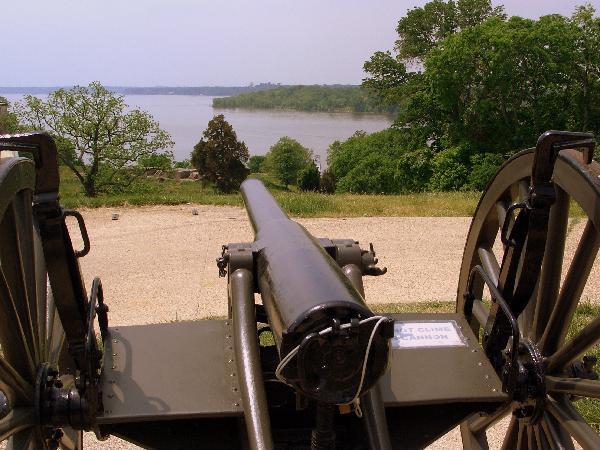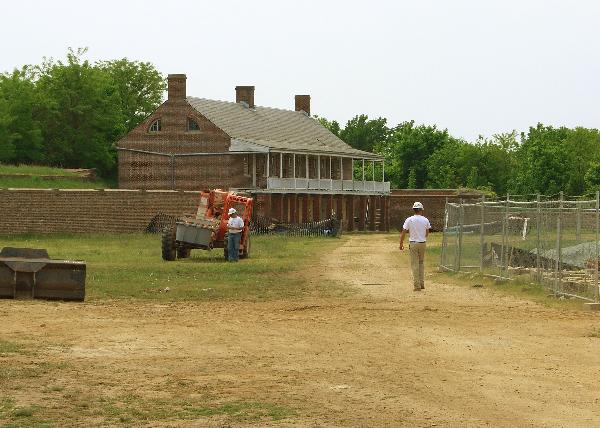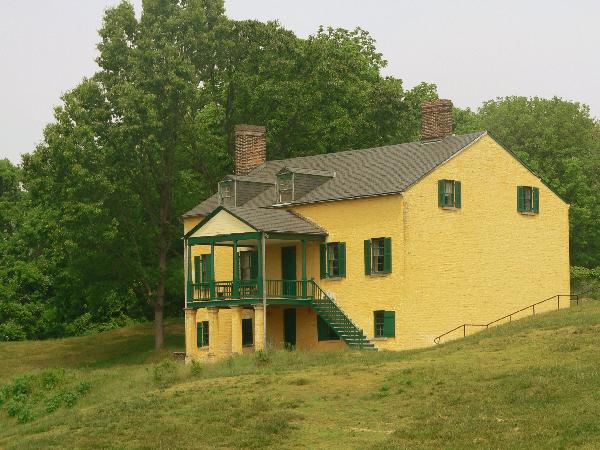NPS Fort Washington Website; NPS Fort Foote Website; Local Fort Washington Website
 WHAT IS IT?
WHAT IS IT?Two long-defunct Potomac River-facing forts whose purpose was to protect Washington DC from waterborne invaders. Neither fort ever faced an enemy’s military attack.
BEAUTY (3/10)
Fort Washington offers stunning views of the wide Potomac River from its hilltop sentry. It is too bad the Fort itself is such a deteriorating mess. Fort Washington’s red brick interior is currently undergoing an intensive facelift; the resulting situation is a loud, fenced-off, permanent construction zone. There are few places to go and even fewer things to see.
Fort Foote, well, we drove there and parked. From the parking lot, there was an indeterminately lengthed walk to the Fort. We skipped the hike and left. Documentation states that Fort Foote is the best-preserved Civil War fort in the area but NPS’ Fort Foote website has no pictures and an Internet search yields only one shot of a 15-inch Rodman gun. We do not think we missed much because there is no Fort Foote Visitor Center and no Rangers on staff.
HISTORICAL INTEREST (4/10)
What if they built a fort and no battles came? That is not such a bad thing, we guess, but it happened at both of these Sites. Fort Washington’s unfortunate history, however, is far more interesting.
The US began construction on Fort Washington in 1809 in order to protect Washington, DC from Potomac-River bound invaders. In 1814, during the War of 1812, the British eluded the Fort’s guns by sailing up the Patuxent River on their way to sacking and burning our nation’s Capitol. During the British retreat down the Potomac, Fort Washington was destroyed; not by the British but from its own soldiers’ misfired explosives.
The Fort was quickly rebuilt and remained an active base for over 120 year until its closure shortly after World War II, but never again faced attack (enemy or otherwise).
CROWDS (5/10)
Lots of people but no actual other tourists viewing Fort Washington. A busload of schoolchildren spent our entire stay (one hour) in the parking lot picnicking and playing football on the asphalt. Had they ever entered the Fort? Who knows?
EASE OF USE/ACCESS (3/5)
Both forts are located along the eastern shore of the Potomac River just south of Washington, DC and sit a short jaunt westward from Maryland Route 210 (the Indian Head Highway). To get onto Route 210, take the DC Beltway (I-495, 95) Exit 2 and go south. Both forts are less than 10 miles away.
 Neither the George Washington Parkway NPS brochure nor the National Capital Parks-East NPS packet show any roads linking Route 210 to either Fort. An absence of roads raised a few flags in the Altima, but we pressed on. Well-placed brown NPS signs pointed us off Route 210 and to the Fort Washington VC parking lot. If you are traveling on 210 from the south: take Old Fort Road; from the north: take Fort Washington Road.
Neither the George Washington Parkway NPS brochure nor the National Capital Parks-East NPS packet show any roads linking Route 210 to either Fort. An absence of roads raised a few flags in the Altima, but we pressed on. Well-placed brown NPS signs pointed us off Route 210 and to the Fort Washington VC parking lot. If you are traveling on 210 from the south: take Old Fort Road; from the north: take Fort Washington Road.The walk from the lot to the VC and adjacent fort was longer and steeper than expected. You have been warned. The route to Fort Foote was trickier, as it weaves through residential neighborhoods. Luckily, there are helpful driving instructions on hand at the Fort Washington VC. As mentioned, the Fort Foote parking lot is not adjacent to the Fort itself; you have to walk through the woods to get there. How long? We don’t know; we didn’t leave the car. The walk could be 100 yards; it could be one mile.
CONCESSIONS/BOOKSTORE (2/5)
There were a few sparsely shelved racks at the Fort Washington VC that scratched the surface of defense fort and assorted local history.
COSTS (2/5)
A $5 per car fee is posted both online and at Fort Washington’s front gate. We saw no Rangers collecting fees. The $5 cost may be suspended during construction; how can you charge when there is nothing to do? Had there been a Fee Station, our National Parks Pass would presumably have covered it.
RANGER/GUIDE TO TOURIST RATIO (3/5)
When we first arrived at Fort Washington, there was a sign on the Visitor Center reading: CLOSED. “How could this be?” we thought while we decided to walk into the Fort. Gab simmered while adding, “If we drove all this way and don’t get any stamps I’m going to be angry.” “Going to be, as in the future?” Michael asked.
Luckily, for all involved, the Ranger staffing the Fort was just out on lunch break. She returned, let us in on the bounty of stamps and answered a few questions.
TOURS/CLASSES (5/10)
The charming yellow Fort Washington VC includes three full rooms of new-ish exhibits. Admittedly, we were less than vigilant in our learning duties. Our quick perusal revealed that much of their info was similar to stuff we learned at other American Coastal Defense System forts; we have been to dozens. Fort Washington would make for a nice initial lesson in multi-generational military history but you must go elsewhere to see a fort that saw fighting.
 FUN (4/10)
FUN (4/10)Could we have spent a more worthwhile two hours of our lives? Sure, but the Fort Washington VC has four different National Parks Passport stamps AND a snazzy lighthouse stamp. Multiple stamp sites always make us happy. A five-stamp site makes us ecstatic. The Fort and its history, however, were nothing special.
WOULD WE RECOMMEND? (2/10)
We have documented our love of forts countless times, or in approximately 40 Site Reviews. But even we cannot recommend a trip down to Fort Washington or Fort Foote. Regardless of how much they spruce the place up, there is still nothing to see.
If its eastern shore Potomac River views you want, go down the road to Piscataway Park where the walk to the water is considerably shorter and there is no charge. Fort Washington’s most appealing draw may be its summer-long, once a month, first week of Sunday Artillery Demonstrations. They promise to be more successful than the misfiring cannons of 1814.
TOTAL 35/80
www.usa-c2c.com
© 2004-06